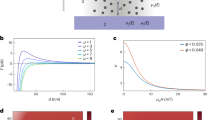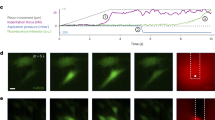Abstract
BANCROFT'S observation that the oil in oil-water emulsions tends to become the continuous phase in the presence of calcium salts and the discontinuous phase in the presence of sodium salts was developed by Clowes (Jour. Biol. Chem., vol. 24, p. xiv; 1916) into a physical explanation of the phenomenon of the action of antagonistic ions on the permeability of cell membranes.
This is a preview of subscription content, access via your institution
Access options
Subscribe to this journal
Receive 51 print issues and online access
$199.00 per year
only $3.90 per issue
Buy this article
- Purchase on Springer Link
- Instant access to full article PDF
Prices may be subject to local taxes which are calculated during checkout
Similar content being viewed by others
Author information
Authors and Affiliations
Rights and permissions
About this article
Cite this article
DIXON, H., BENNET-CLARK, T. Electrical Excitation and the Possible Structure of the Plasmatic Membrane. Nature 124, 650–651 (1929). https://doi.org/10.1038/124650a0
Issue Date:
DOI: https://doi.org/10.1038/124650a0
This article is cited by
-
Zur Frage der narkotischen Erregung und der narkotischen Lähmung
Ergebnisse der Physiologie Biologischen Chemie und Experimentellen Pharmakologie (1941)
-
Modellversuche Zum Wirkungsmechanismus der Narkotika
Protoplasma (1933)
Comments
By submitting a comment you agree to abide by our Terms and Community Guidelines. If you find something abusive or that does not comply with our terms or guidelines please flag it as inappropriate.



